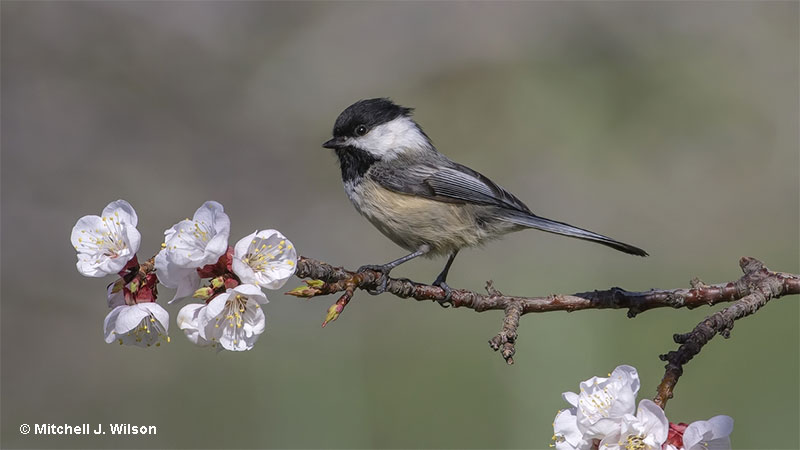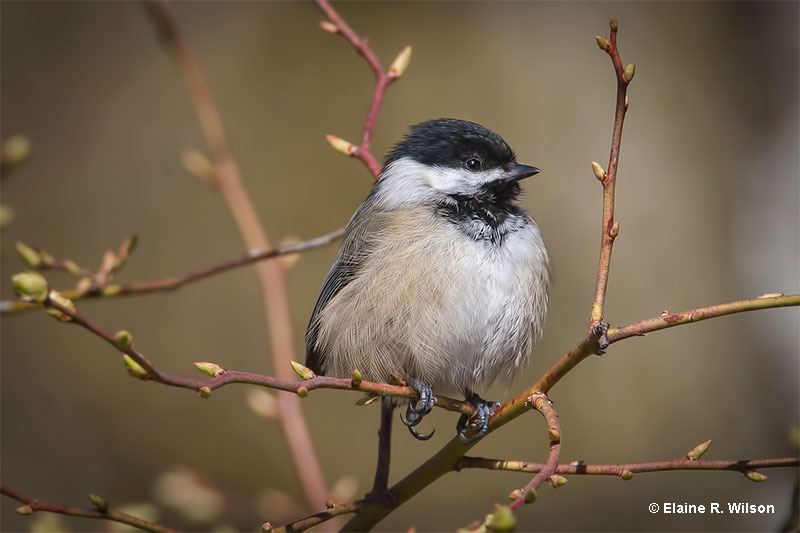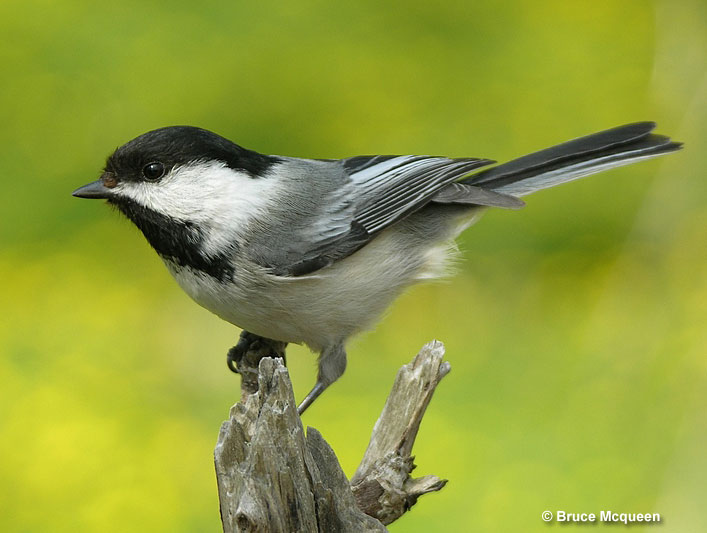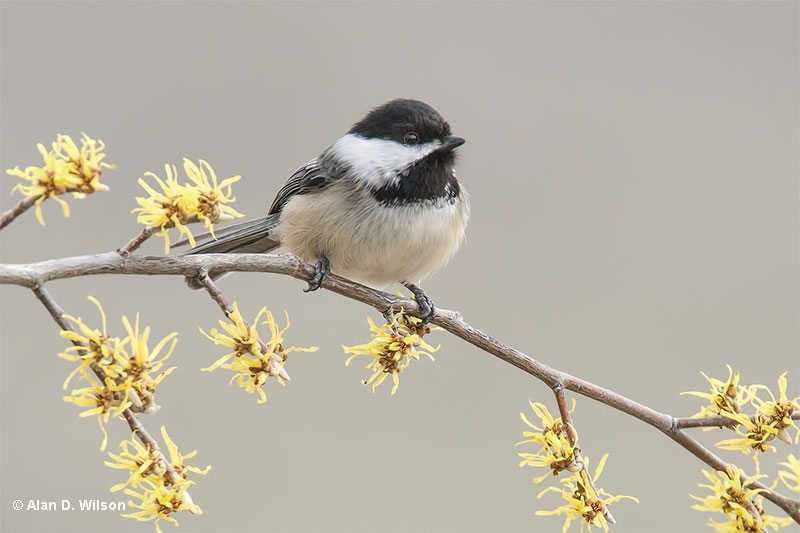
Massachusetts is a northeastern U.S. state whose terrain consists of lower coastal plains, mountains, pioneer valleys, and uplands. It’s a smaller state with a population of 6.981 million and a 10,565 sq mile size.
The state bird of Massachusetts is the Black-capped Chickadee. This cheerful bird is common and loved by many.
On this page
The State Bird of Massachusetts
The Black-capped Chickadee (sometimes referred to as Black-cap Titmouse or just Chickadee) became the state bird of Massachusetts on March 21st, 1941.
Massachusetts shares the Black-capped Chickadee as a state bird with Maine. The small, white-and-black bird enthusiastically greets people, whether it be from bird feeders or in the deciduous or mixed forests.

It’s unclear why Massachusetts selected the Black-capped Chickadee as its bird. However, one can assume it’s because this bird settles in all of the forested areas of the state, like parks, cottonwood groves, open woods, mixed and deciduous forests, and even willow thickets.
Additionally, they’re charming birds that appeal to almost everyone who spots one. They’re also very social and will approach humans often. Due to their openness and how they approach everything in life enthusiastically, they make a great comparison to the residents of Massachusetts.
Fun Facts About Black-capped Chickadees
- Black-capped Chickadees can remember thousands of hiding places. They hide foods like seeds in individual hiding spots for later.
- To keep warm, these birds raise their thick, soft feathers to trap warm air. This makes good insulation during the cold winter months.
- Black-capped Chickadees love peanuts and sunflower seeds. If you want to attract these birds to your feeder, fill them with everything these tiny birds love!
- The oldest recorded wild Black-capped Chickadee was a male. He lived to be at least 11 years and 8 months old. It was initially captured during banding operations in 2009 in New York; it was recaptured and rereleased in the same state in 2021.
- When the breeding season starts, the chickadees’ brains grow larger to allow them to create more sounds.
- Chickadees are known to nest in abandoned Downy Woodpecker cavities, nesting boxes, and small natural cavities.
- Most birds that mingle with Black-capped Chickadee flocks respond to their alarm calls. This is true even when that species don’t have a similar alarm call to Black-capped Chickadees.
- Because of these birds’ curious and friendly nature, Black-capped Chickadees will sometimes land on your hand when offering seed if you’re very still and patient enough.
- In the fall, chickadees allow their body to rid the brain of neurons that store useless information. These are usually unused hiding places for food.
- Black-capped Chickadees always sleep in their own personal nesting cavities. This is true even when temperatures are well below freezing.
Massachusetts State Bird Identification
As members of the titmouse family, Black-capped Chickadees have large heads and short necks, which gives them spherical, distinctive body shapes. Additionally, they have narrow, long tails and bills that are short but thicker than a warbler’s. Overall, these birds are smaller than sparrows.

Black-capped Chickadees have white cheeks, black bib and throat, black caps extending down to their nape, and soft gray backs. Their wings are gray and edged with white. Their underside is soft and has a brownish tinge, ashy-gray on the sides, grading to white below. The cap extends down just beyond their dark eyes, making them hard to see.
Both female and male Black-capped Chickadees are 4.7 to 5.9 inches long, weigh 0.3 to 0.5 ounces, and have a wingspan of 6.3 to 8.3 inches.
What Do Black-capped Chickadees Eat?
In the winter months, the official Massachusetts state bird eats around half animal foods like suet, spiders, and insects (such as caterpillars, insect larvae, and spiders) and half plant matter like seeds and berries. They even enjoy some poison ivy! In the fall, summer, and spring, animal foods make up 80 to 90% of their diet.
Black-capped Chickadees primarily consume mealworms, sunflower seeds, peanut butter, suet, and peanuts at bird feeders.
To consume peanuts, they’ll peck a hole in the shell and chip out tiny bits while expanding the hole each time.
Are you looking to attract these birds to your yard? If so, the good news is they’re one of the easiest birds to attract. They don’t mind using small hanging feeders that swing in the wind. They’re even brave enough to feed from window feeders! If you would like to make your yard more nesting-friendly to these birds, you can plant alder, birch, and trees to provide future nesting habitat.

© Alan D. Wilson
Call
Black-capped Chickadees have a relatively simple song across most of North America. Their pleasing call usually consists of 2 to 3-note whistled hey, sweetie, or fee-bee.e.
In the Pacific Northwest, their song is commonly 3 to 4 notes with the same pitch. In most of its range, male Black-capped Chickadees start singing in mid-January, and the song grows in frequency as the winter continues. Female birds will sing occasionally.
The call of this songbird sounds like chick-adee-dee-dee, using a growing amount of notes when they are spooked. They also produce a gargling call that’s commonly produced harshly when a lowly bird gets too close to a more authoritative one.
Black-capped Chickadees make a high-pitched see as an alarm call, often when a quick approaching threat is seen. When chickadees become aware of this call, they’ll freeze in their current position until they hear a chickadee-dee call that states, “all clear.”
Chickadee nestlings make a loud slap and hiss on the inside of their nesting cavity when an intruder peaks in.
Behavior
Black-capped Chickadees are very curious, acrobatic, social, and active birds. They live in flocks and are commonly seen mingling with nuthatches, woodpeckers, vireos, warblers, and other small woodland species.
They feed on seeds and insects but rarely perch within several feet of each other while eating or taking food. Flocks have been found to have many calls that have specific meanings, and they are theorized to contain some characteristics that are similar to human language.
Black-capped Chickadees usually have one brood per year. Nest-building starts in April. Their nests are made with soft lining, usually moss and similar soft materials. By the beginning of May, they usually have eggs in the nest.
The hatchlings grow quickly and are ready to leave the nest at around two weeks. By June, the young birds are flying around happily!
Massachusetts State Bird – Frequently Asked Questions
What is the state bird of Massachusetts?
Massachusetts has two state birds, the Black-capped Chickadee and Wild Turkey.
Does Massachusetts have two state birds?
Yes, Massachusetts has two state birds: the Black-capped Chickadee and Wild Turkey. Wild Turkey is considered to be the Massachusetts state game bird.
What is the state flower and animal of Massachusetts?
The state flower of Massachusetts is the Mayflower. The state animal of Massachusetts is the Boston Terrier.
Why is the black-capped chickadee the state bird of Massachusetts?
It’s unclear why the Black-capped Chickadee is the state bird of Massachusetts, but it’s theorized that because these birds settle in all of the woody areas of the state as well as being very cute, it makes them appealing to almost everyone who sees them.
Keep reading – Most common birds in Massachusetts & Hawks in Massachusetts

